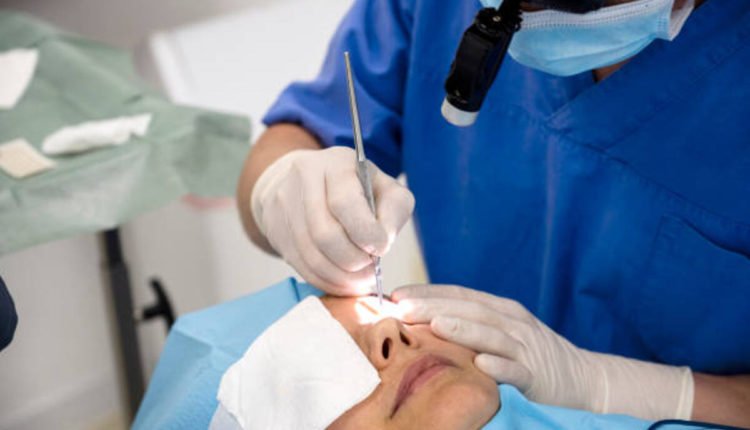This lovely lady in her late forties underwent upper blepharoplasty to eliminate excess skin and expose her stunning blue eyes. As a result, she looks rejuvenated and refreshed! Discover the best info about بلفاروپلاستی پلک.
Eyelid surgery, commonly referred to as blepharoplasty, can also serve a functional purpose by eliminating visual obstruction caused by overhanging upper lid tissues.
Swelling and bruising tend to resolve in about one week.
A patient in her early forties
Eyelids provide us with vision. Therefore, surgical procedures in this area must be carefully evaluated and planned for. An incorrectly performed upper blepharoplasty could have serious repercussions, including difficulty closing your eyes or even loss of vision – although these complications are rare, they should still be reported promptly to your surgeon.
An upper blepharoplasty involves having your doctor make incisions along the eyelid crease, then peel back excess skin and bulging fatty tissues from your eyelid crease before reshaping it and closing its incisions. The process generally takes several hours but requires minimal recovery time – you should be back home soon after surgery!
As we age, our natural elasticity decreases, and the connective fibers that open our eyes weaken, leading to redundant skin and a drooping upper eyelid referred to as ptosis. An upper blepharoplasty procedure can reshape this eyelid for a younger look while improving vision.
Lower blepharoplasty may help you reduce puffy eyelids. This procedure is commonly performed alongside upper blepharoplasty for maximum rejuvenation of your facial features. Your surgeon may make an incision directly beneath your lower lash line or through pink conjunctiva tissue in your lower eyelid to gain access to the fat that needs repositioning or shaping so as to diminish the puffy appearance of your eyelids.
Patient in her late 50s
Eyes are at the core of human expression, communication, and emotion detection. Therefore, many patients become dissatisfied with aging effects on the eye area – particularly excess skin or drooping of the upper lid. If this becomes problematic enough to obstruct vision, then cosmetic or functional upper blepharoplasty may be recommended as a solution.
Age can cause the fat tissue in the upper eyelid to sag, creating a tired or aged appearance and visible shadowing on the upper lid. Sometimes, fat deposits under the eyes may make an additional “bag” or circle that must be addressed; lower lid blepharoplasty or alternative approaches like chemical peel can help.
Upper eyelid surgery is one of the most frequently performed plastic surgeries for both cosmetic and functional reasons, making it one of the most sought-after services provided by plastic surgeons. For optimal results, it should be performed by an ophthalmologist, cosmetic surgeon, or plastic surgeon with extensive training and experience in reconstructive techniques.
This patient underwent both upper and lower blepharoplasty to eliminate extra skin on her eyelids and decrease bags beneath her eyes. She was pleased with her results, loving the new, refreshed appearance.
The patient in her early 60s
This patient, in her early sixties, underwent a conservative upper eyelid blepharoplasty procedure in order to remove some fine-line wrinkling and mild hooding of her eyelids. One year post-procedure, the incision has healed well, and her eyes now look refreshed and awake – giving her more youthful looks and making her very pleased with the results of the blepharoplasty procedure.
Age can cause loose, sagging skin and fat tissue on the upper eyelid to accumulate over time, making the lid appear heavy or even interfere with vision. A blepharoplasty procedure can resect redundant skin and tighten weak ligaments to create a more youthful contour and open up your upper field of view while improving eyebrow arch appearance.
When necessary, a brow lift may be performed concurrently with an upper eyelid blepharoplasty to enhance the overall appearance of the periorbital area. These procedures can be carried out under local anesthesia alone or conscious sedation for optimal results.
This delightful lady in her late 40s underwent both lower and upper eyelid blepharoplasty procedures to address bags and tear troughs, improve her symmetry, and achieve a more rejuvenated appearance. Additionally, a browlift was performed to elevate the tail of the brow and achieve a masculine yet rejuvenated appearance – important when considering male facial structures can differ significantly – so the surgeon must be experienced at working on them without over-feminizing their eyes.
Patient in her late 70s
Blepharoplasty also referred to as eyelid lift or cosmetic eyelid surgery, involves the surgical removal of excess skin from the upper eyelids to enhance overall facial appearance. Also referred to as an “eyelid lift,” this procedure should only be performed by board-certified ophthalmologists, plastic surgeons, or dermatologists with expertise in reconstructive and aesthetic techniques. As eyelids provide one of the most important human senses – vision – it is vital that patients undergo their procedure carefully evaluated and planned prior to their procedure.
Natural aging often results in loose upper eyelid skin and excess fat tissue that causes the lid to sag or hinders vision, hindering any future activities such as driving. Blepharoplasty for aging seeks to create a more youthful look by removing redundant skin and tightening weak ligaments to restore the natural shape of eyelids while decreasing signs of aging such as wrinkles, loose skin, or dark circles beneath the eyes.
This patient in her late 70s underwent cosmetic upper and lower blepharoplasty procedures to address extra skin on her eyelids that was making her appear older than she actually is while also receiving lower blepharoplasty with fat redistribution to improve tear trough deformities underneath both of her eyes (tear trough deformity). As a result of both procedures, she now looks refreshed yet more youthful while remaining natural, all performed in the office under local anesthesia.
Read also: How Does Ayurveda Fit Into Your Busy Life?


